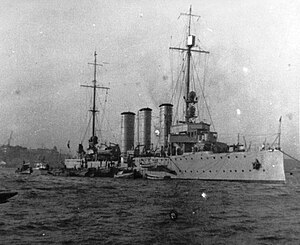SMS Kolberg

In French service as Colmar during her deployment to China in 1924
|
|
| History | |
|---|---|
|
|
|
| Name: | SMS Kolberg |
| Namesake: | Kolberg |
| Laid down: | 1908 |
| Launched: | 14 November 1908 |
| Completed: | 21 June 1910 |
| Fate: | Scrapped, 1929 |
| General characteristics | |
| Class and type: | Kolberg-class cruiser |
| Displacement: | 4,362 metric tons (4,293 long tons) |
| Length: | 130.50 m (428 ft 2 in) |
| Beam: | 14 m (45 ft 11 in) |
| Draft: | 5.38–5.58 m (17 ft 8 in–18 ft 4 in) |
| Installed power: | 19,000 PS (13,974 kW; 18,740 shp) |
| Propulsion: |
|
| Speed: | 25.5 knots (47.2 km/h; 29.3 mph) |
| Range: | 3,250 nmi (6,020 km; 3,740 mi) at 14 knots (26 km/h; 16 mph) |
| Complement: | 367 |
| Armament: |
|
| Armor: |
|
SMS Kolberg was a light cruiser of the German Kaiserliche Marine (Imperial Navy) during the First World War, the lead ship of her class. She had three sister ships, SMS Mainz, Cöln, and Augsburg. She was built by the Schichau-Werke; her hull was laid down in early 1908 and she was launched later that year, in November. She was commissioned into the High Seas Fleet in June 1910. She was armed with a main battery of twelve 10.5 cm SK L/45 guns and had a top speed of 25.5 kn (47.2 km/h; 29.3 mph).
Kolberg saw action in several engagements with the British during the war, including the raid on Scarborough, Hartlepool and Whitby in December 1914 and the Battle of Dogger Bank the following month. She also saw action against the Russians on two occasions, during the Battle of the Gulf of Riga in August 1915 and Operation Albion in November 1917. After the end of the war, she was ceded to France as a war prize and renamed Colmar. She served only briefly in the French Navy, including a deployment to Asia in 1924. She was stricken in 1927 and broken up two years later.
Kolberg was ordered under the contract name Ersatz Greif and was laid down in early 1908 at the Schichau-Werke shipyard in Danzig. She was launched on 14 November 1908, after which fitting-out work commenced. She was commissioned into the High Seas Fleet on 21 June 1910. The ship was 130.50 meters (428 ft 2 in) long overall and had a beam of 14 m (45 ft 11 in) and a draft of 5.58 m (18 ft 4 in) forward. She displaced 4,915 t (4,837 long tons; 5,418 short tons) at full combat load. Her propulsion system consisted of two sets of Melms & Pfenniger steam turbines driving four 2.25-meter (7 ft 5 in) propellers. They were designed to give 19,000 metric horsepower (13,974 kW; 18,740 shp). These were powered by fifteen coal-fired Marine water-tube boilers. These gave the ship a top speed of 25.5 knots (47.2 km/h; 29.3 mph). Kolberg carried 970 t (950 long tons; 1,070 short tons) of coal that gave her a range of approximately 3,250 nautical miles (6,020 km; 3,740 mi) at 14 knots (26 km/h; 16 mph). Kolberg had a crew of eighteen officers and 349 enlisted men.
...
Wikipedia
